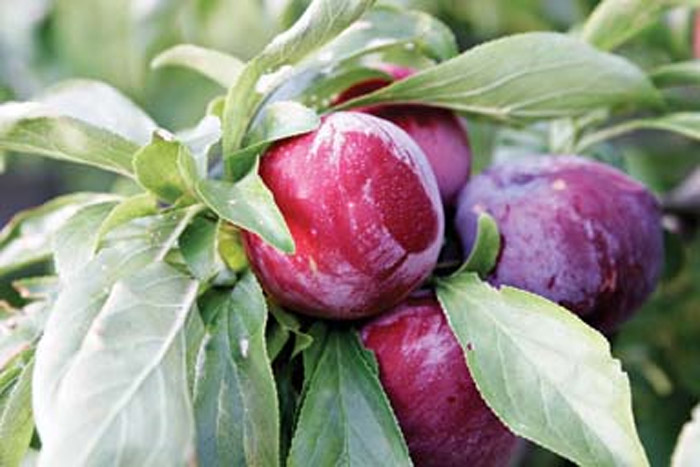Deeply Rooted
The Pits – Part 2

And we are back, lets dive right back into the pits, figuratively. We will start with Native Plums. There are two kinds of Native Plums in our region. The American Plum and the Canadian Plum. No, they are not defined by which side of the border they grow on. American Plums are small with red/purple fruit colour while Canadian Plum has small blue/purple fruit. Both can be grown in our area, but the American Plum gets more publicity around Manitoba.
Cherry Plums are a fascinating puzzle I have been looking into. Which is it? A cherry or a plum? Well, it is a hybrid of two species, Japanese Plum and Sand Cherry, so it is both. Or is it? If my research about Sand Cherry is correct, then the Sand Cherry is actually a Plum variety and so the Cherry plum is a true Plum. They are also highly flexible pollinators for many Plums and Cherries and also make a decent fruit of their own at the same time. Their fruit has red skin and yellow flesh inside like a plum, but they are a bit smaller in size. So, what came first the cherry or the plum? In this case it was the plum!
Japanese Plums are interesting because you do not see many of them in our area. Truly I only learned we sell Japanese Plums a few months ago. The Brook Gold Plum is a purely Japanese Plum that has yellow skinned fruit and is known as one of the sweetest plums for Manitoba. It is also a freestone plum, meaning the flesh lets go of the pit very easily rather than having to suck on the pit for an hour to clean it off. Another Japanese Plum we sell is the Tecumseh Plum. With red/purple fruit, excellent sweet flavour and flexible pollination it comes highly recommended. It is still new to our area, and we are testing its cold tolerance, but so far so good.
Hybrid Plums are a combination of the Japanese Plum and the American Plum in an attempt to get the best traits of both in one tree. The American Plums are known for their resilience and productivity while the Japanese Plums are known for their flavour. Most of the plums we are familiar with here in Manitoba are such hybrids, including Pembina, Brook Red, Toka, and Queen of Hearts Plums, a new variety released only recently and may very soon be ruling over the other hybrid Plums. So far, the Toka Plum is a personal favorite with sweet flavour and a ripening time a month later than other plums. But we will see what happens once I taste fruit from the Queen of Hearts Plum.
Lastly, European Plums. These are the beautiful blue Plums you find in the grocery stores. Juicy and sweet without the sour skin that most of our locally produced plums will have. The Mount Royal Plum is rated as zone 4 and therefore… almost grows here. It is self fertile and will not pollinate with our native plums or Japanese Plums. But they will pollinate with… Manchurian Apricot? Apparently! Oh, did I forget to mention that the Apricots can also be pollinated by Nanking Cherries and Russian Almonds? We are seeing a trend here. All these varieties come out of central Asia where they would naturally exist together. The Plum would be a bit to the East, but not too far away to work together. It’s when you start growing things from the seeds of these crossbreds that you get weird stuff like Cherry Plums or Black Nanking Cherry. Apparently the cross of Apricot and Russian Almond is highly beneficial. The fruit can still be sold and eaten like any Apricot, but the pit, once shelled, can be eaten like an almond!
Actually, I guess I should add the Flowering Russian Almond to this list too. Also from the Prunus family, Russian Almond grows as a 4′ bush, prone to sucker over short distances and make a small thicket if left unchecked. The Flowers are remarkably similar to those of an Apricot tree in colour, style and timing of bloom. The bush is very cold tolerant and easy to keep alive and healthy. The fruit is a true Almond, but smaller, tough and reportedly bitter. Obviously, I have tried one or two of them raw and there was nothing bad about them, but also not much that was impressive. Their nutritional value however is said to be through the roof! I guess we cannot write anything off too quickly… I will wrap up this little series with one last write up on apricots and peaches, so stayed tuned for that!




